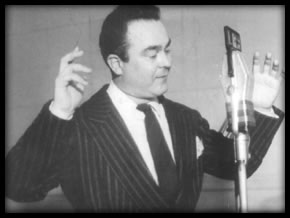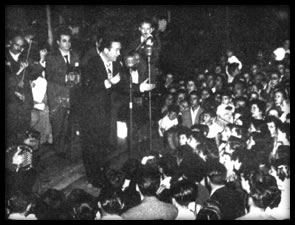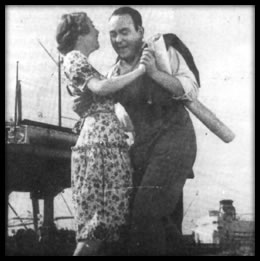By
Alberto Castillo, the singer of the milongueros (Tango is a high quality dance)

ccording to Jorge Göttling tango «is a way of being and feeling and the outskirts are not only a notion of cadastre». Then after these expressions is possible to say that the word porteño encloses a conjunction of codes and connotations. It is necessary then to understand the why of the importance that for “yesterday’s tango man” the forties have and the mystery that the latter mean for today dancers.
 Those that at their time lived them, reminisce them with nostalgia and today youngsters do their best to find its secret. It is nothing new that the forties were recorded in the history of tango as a “golden period”, even though its magic, we can say, goes beyond the mid- fifties.
Those that at their time lived them, reminisce them with nostalgia and today youngsters do their best to find its secret. It is nothing new that the forties were recorded in the history of tango as a “golden period”, even though its magic, we can say, goes beyond the mid- fifties.
It was at that time when the singer began to be heard to greater advantage in the orchestras, becoming a sort of additional instrument for the orchestras.
Furthermore, lyricists acquired a new profile. Their lines speak about love and women are mentioned in a different way. They also highlight the city, the neighborhood and the dancers known as milongueros. Within that frame the lyrics of tango achieve a greater importance and are welcome by the public. Since then melody shares its important role with lyrics.
 In the early forties maestro Ricardo Tanturi included in his repertoire compositions that not only highlighted tango as a dance but also the dancers (milongueros). It is worthwhile mentioning as example pieces like “Al compás del tango”, “El tango es el tango”, “Cuatro compases”, “Canción de rango” and the most successful “Así se baila el tango”; all them sung by Alberto Castillo.
In the early forties maestro Ricardo Tanturi included in his repertoire compositions that not only highlighted tango as a dance but also the dancers (milongueros). It is worthwhile mentioning as example pieces like “Al compás del tango”, “El tango es el tango”, “Cuatro compases”, “Canción de rango” and the most successful “Así se baila el tango”; all them sung by Alberto Castillo.
In his shows at dance rooms, before starting with the lyrics of “Así se baila el tango”, Castillo recited these lines:
Una corrida elegante,
tras la vuelta una sentada
y un ocho bien compadrón.
Así lleno de emoción
yo me lucí en mil fandangos,
porque así se baila el tango de alma,
de alma y de corazón.
Después de lo cual atacaba con:
¡Qué saben los pitucos, lamidos y shushetas!
¡Qué saben lo que es tango, qué saben de compás!
Aquí está la elegancia. ¡Qué pinta! ¡Qué silueta!
¡Qué porte! ¡Qué arrogancia! ¡Qué clase pa’bailar!
These lines written by Elizardo Martínez Vilas (Marvil) were sung and performed by Alberto Castillo wittily, adding to them mimicry to emphasize the intention suggested by the lyrics.
 Castillo, by doing this, expresses his own physical and sentimental nearness to those to whom it is directed, that is to say, the tango dancers, on the one hand, while mocking those usually called «petiteros» on the other. («figurines» boys that frequented the Petit Café of Santa Fe and Callao).
Castillo, by doing this, expresses his own physical and sentimental nearness to those to whom it is directed, that is to say, the tango dancers, on the one hand, while mocking those usually called «petiteros» on the other. («figurines» boys that frequented the Petit Café of Santa Fe and Callao).
We can surely say that this tango piece was not only the one that launched Alberto Castillo to fame, but also the one which praised and made the dancers of that time become boastful.
The virility extolled in its lines encouraged the young to throw themselves into tango influencing them to dance according to what is said in the lyrics and so to reaffirm their male condition. For a long time a whole generation of milongueros boasted having witnessed, at this or that club, the rows that sprang up every time that Castillo began “Así se baila el tango”. True or false, most them affirmed they had witnessed them and the most audacious boasted having taken active part at such skirmishes.
Many years later in an interview for the radio, with an evident nostalgia, Castillo commented those events using a way of saying half easygoing, half bantering, as he always used to do.
At a time during the interview Antonio Carrizo told him:
«But you gave a special emphasis to the words «qué saben los pitucos» (what do the hell the fashionable guys know?). It seemed something done on purpose, just like throwing a rocket into a dish of spaghetti».
 «No, no», Castillo answered and cunningly added: «You know, it didn’t mean an offence, , because it is not dedicated to anyone, not even a hint to anyone. This was something that I was defending, like saying: how can they know?».
«No, no», Castillo answered and cunningly added: «You know, it didn’t mean an offence, , because it is not dedicated to anyone, not even a hint to anyone. This was something that I was defending, like saying: how can they know?».
«But if I was dancing to a "boogie-woogie" or a "little conga" with a flirt; wearing a nice suit, a pretty tie, well combed» —continued Carrizo— and added: «It seems to me that you were after some quarrel!»
«No, really, I tell you, never, never», answered Castillo.
«And what did Tanturi and his musicians, all them professionals, say? Why on earth did we bring this guy who's gonna make us all have a good beating?»
«Well, finally it was such a hit that he was happy. He was glad because of the effect it produced, you see?. Then the "tangueros" easily swayed, enjoying everything and... as I was telling you, those who considered themselves alluded, well...»
«And on what side were the girls?», asked Antonio Carrizo.
«The girls were with me, things were that way».
During the interview, the inflection of his voice and the intentioned pauses, allow us to ponder in Alberto Castillo, sincerity and mischievousness -gifts that he always evidenced in his performances- the same ones that allowed him later to develop a special interpretative feature.
But as soloist Castillo adopted a new style. His movements on the stage, his way of handling the microphone, the exaggerated handkerchief in his upper pocket as an ornament, his shirt with its neck unbuttoned, his loose tie and his right hand close to his mouth -in the manner street vendors used to shout out the products they sold- make him an unusual character. He is a different singer and his followers started to crowd the places where he appeared.
Alberto Castillo never hid his condition of street corner boy identified with his public. The same one that in 1944 forced the police to cut the traffic on Corrientes avenue in front of Teatro Alvear where he was performing. According to José Gobello: «he was the last tango singer that was followed by crowds and his group of fans were called hinchada (like in soccer)».
His physical and sentimental nearness with the then "tanguero" allowed him to bring to tango one more reason for its revival, especially as far as dancing is concerned.